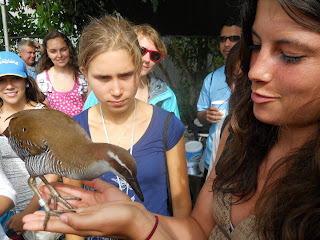I never thought I’d feel sorry for a crow. “He lost his mate on Friday,” our guide said. “It was a very sad day… now he’s only one of two Guam crows left.” She explained that this type of crow was often killed in order to avoid the land use restrictions that come with the presence of endangered species on your property. “I’ve asked each staff member to come out here and have lunch with him once a week. Otherwise, he gets too lonely.”
Today, we visited the Guam Department of Agriculture, which houses many of Guam’s most endangered species. Many of the animals that had no natural predators and slept too soundly quickly became snake food when the brown tree snake was introduced onto the island. We held kokos, a flightless ground dwelling bird that is completely extinct in the wild, with the exception of a one population released from captivity. Every bird raised in captivity has descended from just 10 individuals. We watched as a Guam fruit bat playfully nibbled our guide’s hand. The bat has to be kept indoors at all times to avoid theft – fruit bats are considered a delicacy in Guam.
Many of the most endangered animals are considered the tastiest. Our guide told us about a recent wedding in Guam. The bride and groom published in the local newspaper that they intended to serve kokos and sea turtles as part of the ceremony. I wonder if this was a genuine cultural need, or a conspicuous political statement?
The colonization of Guam by the Spanish, the Japanese, and the Americans has brought vast changes to the traditional subsistence lifestyle. The way people on Guam have lived for thousands of years was supplanted by a distinctly commercial culture. People on Guam have always eaten bats, turtles, kokos, and parrotfish, and American activities on Guam have disproportionately affected these populations when compared with local residents’ activities historically.
At the same time as American policies restrict the way individuals can use their own land and suppress traditional cultural activities, the United States takes actions in Guam that are devastating to local animal populations. The US Navy has a policy that no endangered species can be introduced on Navy property, not even on lands reserved for habitat development. The commercial consumption that is the cornerstone of American living is widely given moral preference to hunting threatened species, but is just as harmful to the environment. The only difference is that the harms of killing and eating fruit bats are felt locally, whereas the products that travel thousands of miles only to be consumed and discarded in seconds have more distant harms. Americans don’t get to see the direct impacts of our everyday choices – out of sight, out of mind. How can we expect to enforce conservationist policies that prohibit millennia-old cultural rituals when we propose to dynamite the coral reefs the policies aim to protect?
The policies enacted to protect environments like Guam are insufficient; restricting certain activities of certain groups will not address the cause of environmental destruction or lead to solutions for the future. A global cultural change that causes individuals feel responsible for the impacts of their lifestyle must occur to catalyze effective action. Prohibitive laws are merely an indirect way of addressing the plight of the bat, the koko, the turtle, the crow, and all the animals that will drift into extinction without ever making it to any sort of watch list. People must know what it feels like to look at a bird with the knowledge that it might be one of the last of its kind. People must know what that loss means for the ecosystem. And people must know what loss means for humanity. Watching the agitated kingfisher screech around his cage as we were told that mathematical models predicted the demise of his species within the decade made me wonder how often my children will ask me, “Did you really get to see one of those?”


No comments:
Post a Comment